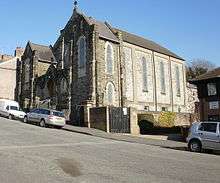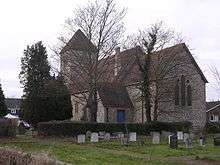Habershon and Fawckner
Habershon & Fawckner or Habershon, Pite & Fawckner was a British architectural practice active in England and Wales from the 1860s, particularly in Cardiff and the South Wales area. They had had offices in London, Cardiff and Newport, designing a large number of houses, villas and non-conformist chapels.

Background
William Gilbee Habershon (c.1818–1891) began practising in St Neots, Huntingdonshire in 1843, in partnership with his brother Edward. The brothers were the sons of the architect Matthew Habershon.[1] Mathew Habershon, as well as working in London, had already established an office in Newport. By the time of their father's death in 1852, the two sons were practising from 38 Bloomsbury Square in London and presumably had inherited their father's practice.[2] In 1852 William Habershon was elected an FRIBA and Edward an ARIBA. The partnership between the brothers was dissolved in 1863 and William Habershon formed a new partnership with one of his pupils, Alfred Robert Pite (b. 1832-1911). James Follet Fawckner (c.1828–1898) became a partner (though he was not a registered architect) in 1870[3] – he had been part of the Habershon company since 1857.[4] After Pite retired aged 45, the practice continued as Habershon & Fawckner. The business had offices in London, Cardiff and Newport, Wales[3] (W.G. & E. Habershon had previously run an office in High Street, Cardiff).[5] The Newport office was run by Fawckner, who was probably responsible for the firms South Wales chapels.[4] After Habershon's death in 1891 Fawckner became the senior partner.[6]

The firm (preceded by W.G. & E. Habershon) were architects for the Tredegar Estate in South Wales.[7] They laid out large parts of Cardiff with parallel streets of villas for the middle classes.[8] They included the streets around The Parade, The Walk, Richmond Road and Richmond Crescent (now in Roath) named 'Tredegarville' at the time.[9] Cardiff's working class residential area of Splott was laid out by Habershon & Fawckner[10] between 1875 and 1899, with the firm basing themselves at the Tredegar Estate offices on Pearl Street.[5] They were responsible for over 1700 houses. Habershon's name was given to Habershon Street, while Hinton Street may have been named after Fawckner's son, Edgar Hinton Fawckner.[5]
The company was busy in Newport, building three Anglican churches and at least fourteen chapels between 1857 and 1907.[11]
In 1891 Habershon & Fawckner designed a mansion on Richmond Crescent, Cardiff, named 'The Grove' (later 'The Mansion House' and home of the city mayor), for shop owner James Howell and family. The mansion included Roccoco detailing and an unusual double front entrance in case the house needed to be divided at a future date.[8]
Notable buildings
As Habershon & Pite
- Baptist Chapel, Stow Hill, Newport (1862–63) [12]
- Presbyterian Church, Havelock Street, Newport (1864) [12]
- Conway Road Methodist Church, Romilly Crescent, Canton, Cardiff (1869–71) [13]
- Thomas Rotherham College, Moorgate Road, Rotherham (1874-1876)(originally built as Rotherham Congregational College; used by Rotherham Grammar School from c.1890 until c. 1971)[14]
- Christ Church, Totland, Isle of Wight (1875)[15]
As Habershon, Pite & Fawckner

As Habershon & Fawckner
- Bethel Methodist Church, Stow Hill, Newport (1882–83) [12]
- Parc Hotel, Park Lane, Cardiff, 1884.[18]
- 165 Commercial Street, Newport (1886) [19]
- Talbot Tabernacle, Talbot Road, Kensington, London [20]
- 31-33 Commercial Street, Newport (1889) [19]

- St Michael and All Angels Church, Partridge Green, West Grinstead, Sussex (1890–) [21]
- Barry Market, Barry, Glamorgan (1890) [22] (later used as a concert hall)
- Sunday Schools, Romilly Crescent, Cardiff (1891), accompanying the earlier Methodist Church [13]
- 'The Grove', Richmond Crescent, Cardiff (1891–96) [8]
- Splott Road Methodist Chapel, Splott, Cardiff (1896) [23]
As Habershon, Fawckner & Groves
- Wesleyan Methodist Chapel, Commercial Road, Newport (1899) [24]
- Clytha Primary School, Newport (1900–1) [25]
- St Andrews United Reformed Church, Wellfield Road, Cardiff (1899–1901) [26]
- Queen Victoria Memorial (almshouses), Stow Hill, Newport (1901–2) [27]
As Habershon, Fawckner & Co.
- United Reformed Church, Pen-y-wain Road, Roath Park, Cardiff (1909–10) [28]
References
- Colvin H. A. (1995) Biographical Dictionary of British Architects 1600–1840, Yale University Press, 3rd edition London, 442-3
- Antonia Brodie (ed) (2001) Directory of British Architects, 1834–1914: Vols.1, British Architectural Library, Royal Institute of British Architects, pp805-6
- "Habershon, Pite & Fawckner". Dictionary of Scottish Architects. Retrieved 2014-11-07.
- "Architects and Artists H - W G Habershon M E Habershon". Sussexparishchurches.org. Archived from the original on 2013-11-09. Retrieved 2014-11-08.
- Childs, Jeff (2012), "Architects", Roath, Splott and Adamsdown: One Thousand Years of History (eBook), The History Press, ISBN 978-0-7524-8257-6
- "James Follet Fawckner". Dictionary of Scottish Architects. Retrieved 2014-11-08.
- Newman, The Buildings of Wales: Glamorgan, p. 105
- Mortimer, Dic (2014), "10 - Roath (including Cyncoed and Lakeside)", Cardiff: The Biography (eBook), Amberley Publishing, ISBN 978-1-4456-4251-2, retrieved 2014-11-07
- Newman, The Buildings of Wales: Glamorgan, p. 309
- Newman, The Buildings of Wales: Glamorgan, p. 311
- Newman, The Buildings of Wales: Gwent/Monmouthshire, p. 428
- Newman, The Buildings of Wales: Gwent/Monmouthshire, pp. 431–435
- Newman, The Buildings of Wales: Glamorgan, p. 278
- Source: Listing description for TR College)
- Lloyd & Pevsner 2006, p. 145.
- Newman, The Buildings of Wales: Glamorgan, p. 586
- Newman, The Buildings of Wales: Gwent/Monmouthshire, p. 457
- Newman, John (1995), The Buildings of Wales: Glamorgan, Penguin Books, p218
- Newman, The Buildings of Wales: Gwent/Monmouthshire, p. 449
- "Survey of London: volume 37: Northern Kensington - CHAPTER XII - The Portobello and St. Quintin Estates". British History Online. Retrieved 9 November 2014.
- "A New Church For Partridge Green. Interesting Ceremony". The Sussex Express. 3 June 1890. p. 8. Retrieved 2014-11-11 – via British Newspaper Archive.
- "Opening Of A New Market At Barry". Western Mail. 12 December 1890. p. 6. Retrieved 2014-11-11 – via British Newspaper Archive.
- "Splott Road English Wesleyan Methodist Chapel, Habershon Street; Barnaby Street, Cardiff". RCAHMW. Retrieved 8 November 2014.
- Newman, The Buildings of Wales: Gwent/Monmouthshire, p. 436
- Newman, The Buildings of Wales: Gwent/Monmouthshire, p. 442
- Newman, The Buildings of Wales: Glamorgan, p. 302
- Newman, The Buildings of Wales: Gwent/Monmouthshire, p. 452
- Newman, The Buildings of Wales: Glamorgan, p. 304
Sources
- Lloyd, David W.; Pevsner, Nikolaus (2006). The Isle of Wight. The Buildings of England. London: Yale University Press. ISBN 978-0-300-10733-3.CS1 maint: ref=harv (link)
- Newman, John (1995), The Buildings of Wales: Glamorgan, Penguin Books, ISBN 0-14-071056-6
- Newman, John (2000), The Buildings of Wales: Gwent/Monmouthshire, Penguin Books, ISBN 0-14-071053-1